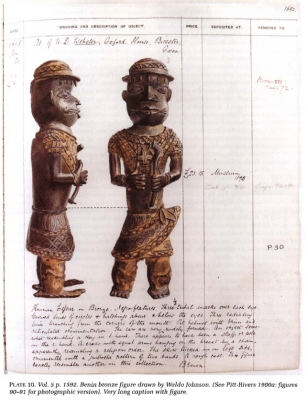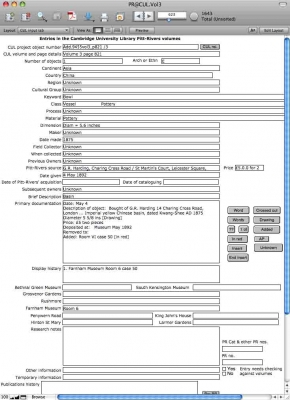To search the RPR site click here
Progress 1: September 2009 - end February 2010
This is the first of six progress reports, to be presented six-monthly. To find out more about the project go here.
The project began on 1 September 2009. During a previous research project (also funded by the Leverhulme Trust [LT]) the same researcher (Petch) had prepared a database of all the items donated to the University of Oxford by Augustus Henry Lane Fox Pitt-Rivers in 1884 as the founding collection of the Pitt Rivers Museum. This database formed the basis for the Museum's collections management system which manages all the data for all the artefacts in its care, including the founding collection. This large database can be consulted here, though it is the intention of this project to make the data about the founding collection available via this site, in the long term.
The key to this new project was the catalogue, contained in nine volumes, of the artefacts Augustus Pitt-Rivers' acquired after 1880. These volumes, which had been held by the Pitt-Rivers family, are now part of the collections of the Cambridge University Library [CUL]. The first task was to scan the pages of these volumes so that detailed research could be carried out on them in Oxford. The LT, as part of its funding for this project, had funded the CUL's work in scanning the 3000 plus pages of catalogues to a very high standard. The project team is most grateful to the CUL's staff who produced such wonderful scans: Don Manning and Les (surname unknown). We are also grateful to Frank Bowles, Godfrey Waller and Dr Zutshi from the manuscripts department. The project team was lucky that the CUL staff were able to provide the scans very early in the project's life, which expedited the research work. The previous work on the founding collection formed the template for the database which was created to import data from the scans of the pages of the catalogue. An example of such a page is shown here. The textual pages of the catalogue were transcribed accurately into a new database and this data has been extrapolated and researched to compile a fully searchable and comprehensive database using Filemaker Pro.
During the first six months of the project some 12,200 new records have been prepared by the researcher. These include the details of around 13,500 objects. She completed transcribing and undertaking preliminary research on the first three volumes of the catalogues by mid February. Volumes II and III are particularly large, and it is thought that these 3 volumes comprise roughly one half of the overall task of preparing the database. From volume 4 transcription became easier and quicker. This was mostly because fewer objects were recorded per page and the volumes had fewer pages. Descriptions had also become more standardized though sadly the high standards of documentation adhered to by Peacock (for the short period he worked on the catalogues) were lost in volumes 4 and 5 by the rather scattered and disorganized entries written by Waldo Johnson. Volume 4 was transcribed in a little over a week (it comprises some 238 pages in total and contains information about 681 objects) and this level of speed was sustained. During the remainder of February and all of March she transcribed volumes 4-9 except for the last twenty pages or so of volume 9 which comprise a large number of entries, without drawings, in list form (obviously a late attempt at batch input).
Although transcribing the entries has been a full-time task the researcher together with Dan Burt (the project web designer), Haas Ezzet (the Museum's Head of IT services, and Jeremy Coote (PI for this project) have prepared and made live this website for the project. It is the intention that this website will be added to and enhanced throughout the life of the project. One of the first things the researcher produced was a series of webpages about Pitt-Rivers life, including a biography, information about his residences, and a series of pages of the events that took place in each year of his life based upon the various biographies, a D.Phil thesis by Bill Chapman and the researcher's own research, see here for those.
Another major research resource that was made available during this period (though its contents will continue to be added to over the next few months while transcription continues) was a database which provided information about all the people associated with the founding collection and the second collection after 1880. This is available here. Currently this is a search-only resource available only via this website, so it does not appear when names are searched by outsiders via google, but once all the names have been added it is anticipated that the resource will be made more search engine friendly which will enable people who know more about the individuals listed than the researchers to send information. [This has subsequently happened]
In addition, a bibliography was made available based upon one produced by the researcher over the last ten years, which lists sources useful when studying Pitt-Rivers' life and collections.
The final resource, which has been provided in the first six months of the project, is that new object biographies have been written and presented on the site about some of the objects from the two collections. It is the intention of the project that students and staff at the Pitt Rivers Museum in Oxford, and other interested parties be invited to write object biographies about things that interest them. This is based on the highly successful object biographies section of the previous research project worked on by the researcher, the Other Within project. As with all other aspects of the website, this section will hopefully increase greatly over the life of the project.
A section of the website was added to reflect the difficulties sometimes experienced by the researcher during transcription. Some entries do not contain textual descriptions, merely illustrations; and a very few of these illustrations are not clear enough, or are not known by the reseachers. It was agreed to establish a section called 'Mystery objects' to show these images and hope to find, via the web, people who are able to identify the type of object. Amazingly within hours of this resource being made live the research team had received its first response and we are very grateful to Ny Björn Gustafsson of Stockholm University for being so prompt. We encourage all visitors to the site to check this page regularly and help the work of the project directly.
The team looks forward very much to the next six months of the project when, hopefully, a brand new resource will become available - the full transcriptions and scans making the next stage of research much easier and providing a very valuable resource for other researchers. The team (Coote, Gosden and Petch) have also been discussing the proposed events associated with the project including the theme for the conference.
Alison and Chris Gosden had worked with Peter Rivière, Professor Emeritus of Social Anthropology of the University of Oxford and Fellow Emeritus of Linacre College, Oxford, on the ESRC-funded Relational Musueum project, and Peter has been kind enough to volunteer to work again with the Rethinking Pitt-Rivers project team.
Alison Petch and Jeremy Coote, Pitt Rivers Museum Oxford
31 March 2010





